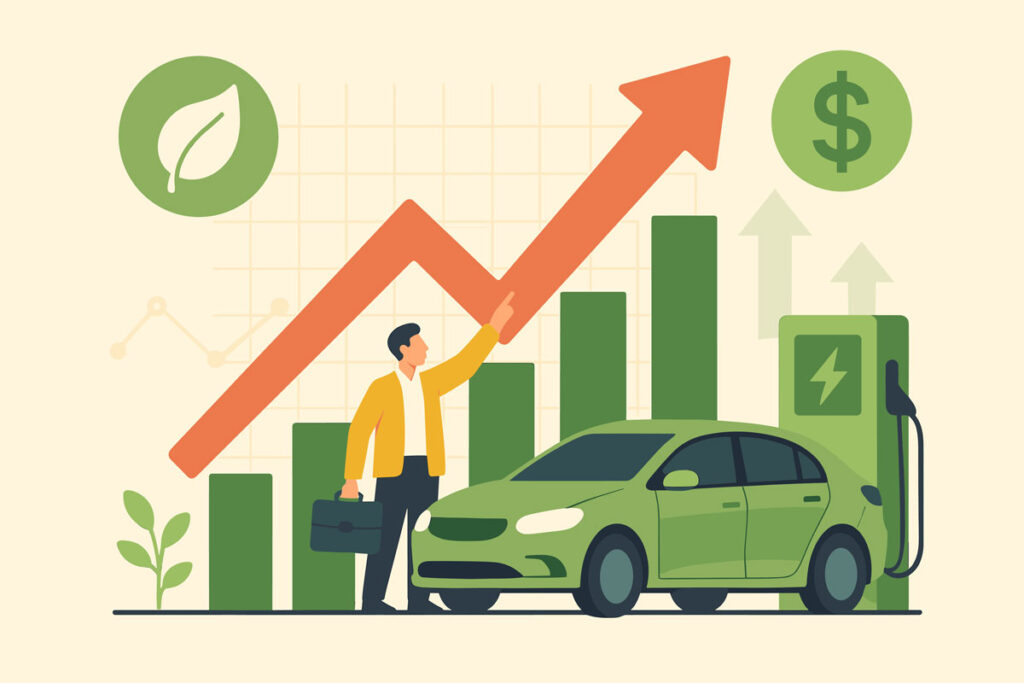July ’25 Market Pulse

EV Market Overview
The EV market remains highly volatile, largely due to a mix of inflation, rising production costs, and new trade barriers. Costs have increased in many of the fundamental raw materials like lithium, aluminum, copper, and nickel that make EV components, which in turn makes them (especially batteries) significantly more expensive. This financial strain has been further intensified by President Donald Trump’s implementation of a sweeping 25% tariff on imported EVs and components, particularly those sourced from China, which supplies much of the global EV supply chain. All of this, of course, has left many EV manufacturers facing an unpredictable future, struggling to adapt to higher costs while maintaining affordability for consumers.
Rising prices are making it harder for the everyday customer to afford electric vehicles, slowing consumer adoption just as the industry was beginning to scale. As a result, many companies, such as General Motors, are slowing down their EV plans and redirecting some of their investment back into internal combustion engine vehicles. On the other hand, some global automakers such as Hyundai have managed to sidestep the impact of these tariffs by restructuring their supply chains or localizing production, positioning themselves more competitively in the U.S. market despite President Trump’s mandated tariffs.
Adding to the uncertainty, federal rollbacks have targeted environmental regulations that had previously supported EV adoption. These actions suggest a shift in policy priorities regarding the pace of the transition to electric vehicles.
Economic Indicators
| Economic Indicator | Current Trend | Impact | Regional Note |
| 1. GDP (Gross Domestic Product) | The U.S. GDP growth rate has slowed slightly in Q2 2025, hovering around 1.6% annualized. | EV makers like GM and Ford are pulling back investment. Tesla remains resilient due to its global presence. | Growth varies across regions. California and Texas continue to advance energy initiatives, while Midwest regions tied to legacy automakers face greater exposure to the slowdown. |
| 2. Nonfarm Payroll & Employment | 185,000 jobs added in May; 4.0% unemployment. | A relatively strong labor market shows consumer demand remains stable. However, manufacturing job growth has plateaued. EV plants in Michigan, Ohio, and Kentucky face hiring slowdowns due to policy uncertainty. | Southern states (Georgia, Tennessee) see stronger growth thanks to Hyundai/Kia expansion. Innovative infrastructure jobs are lagging due to funding delays. |
| 3. CPI (Consumer Price Index) | Inflation at 3.4% YoY as of May. | EV affordability is falling. Entry-level buyers are priced out despite tax credits. | Demand remains strong in urban areas like LA or NYC, supported by incentives; rural regions show less interest, hindered by higher prices and limited charging access. Due to EV price sensitivity, traditional vehicles remain relatively more affordable. |
| 4. PPI (Producer Price Index) | Up 2.8% YoY, signaling ongoing pressure on businesses due to higher input costs. | Battery costs (30–40% of EV price) have jumped 15–20%. Manufacturers face higher prices for lithium, aluminum, copper, and nickel. | Factories in Nevada, Texas, and North Carolina are among the hardest hit by rising import costs. Tariffs on Chinese components are driving supply chain shifts or delays. This is causing many U.S. companies to restructure supply chains or delay product launches. |
Electrified Transportation in the News
In June 2025, the electric and autonomous vehicle industry is undergoing major transformation driven by innovation, infrastructure expansion, and evolving policy landscapes. Companies like Aurora Innovation and Glid Technologies are pioneering commercial autonomous trucking services. Aurora’s trucks operate fully autonomously between Dallas and Houston “equipped with computers and sensors that can see the length of over four football fields” (Skores, 2025). This advancement follows years of development and signals a new era in freight logistics.
Similarly, Glid Technologies is testing a dual-mode, cab-less truck that “can autonomously connect to the kingpin and rear axle of a semi-trailer and then drive from … private lots and onto the rails.” (Ghoshal, 2025). This integration of road and rail transportation offers potential cost savings and efficiency gains across the logistics sector.
In terms of infrastructure, Hyundai Motor Group has invested billions in electric vehicle manufacturing facilities in Georgia, aiming to produce over 500,000 EVs annually. Its strategic location near the Port of Savannah means that the EVs made in there “are going to be exempted from any tariffs” (Merano, 2025). This move not only reduces production costs but also positions Hyundai competitively against U.S. automakers like Tesla and GM.
However, policy shifts have introduced significant uncertainty. President Trump’s rollback of California’s EV mandate removes a regulatory push that previously required “a 2035 target of all new-car sales being electric” (Nieves, 2025). Leading EV makers’ shares “had a mixed reaction to the bill signing” (Revell, 2025). While this disrupts adoption momentum for some automakers, others remained largely unaffected.
Despite policy volatility, the market outlook suggests cautious optimism. A projected 30% jump in EV market share is tempered by concerns over tariffs and shifting tax incentives. “There’s just a lot of uncertainty in the air,” says Stephanie Brinley of S&P Global Mobility. “It’s not an environment where you want to necessarily go gangbusters” (Barnes, 2025).
Together, these developments highlight an industry pushing forward through technological innovation and infrastructure investment, even as regulatory changes shape and challenge the path ahead.
Works Cited
Barnes, A. (2025, September 1). Uncertainty over Trump’s EV policies clouds 2025 forecast for car makers. Euro News. https://www.euronews.com/business/2025/01/09/uncertainty-over-trumps-ev-policies-clouds-2025-forecast-for-car-makers
Ghoshal, A. (2025, May 6). Cab-less truck glider leaps autonomously between road and rail. New Atlas. https://newatlas.com/transport/autonomous-road-rail-truck-glid-2025/
Merano, M. (2025, March 7). Hyundai’s $7.6B Georgia plant dodges Trump’s 25% tariffs. Teslarati. https://www.teslarati.com/hyundai-georgia-plant-vs-trump-tariffs/
Nieves, A. (2025, June 12). Trump revokes California’s nation-leading electric vehicle mandate. Politico. https://www.politico.com/news/2025/06/12/trump-revokes-californias-nation-leading-electric-vehicle-mandate-00402601
Revell, E. (2025, June 12). Auto stocks mixed after Trump signs rollback of California EV mandate. Fox Business. https://www.foxbusiness.com/politics/auto-stocks-mixed-after-trump-signs-rollback-california-ev-mandate
Skores, A. (2025, May 2). The first driverless semis have started running regular longhaul routes. Eyewitness News. https://abc7ny.com/post/first-driverless-semis-have-started-running-regular-longhaul-routes/16302928/
Writer:
Mason King
Market Intelligence
ASPIRE